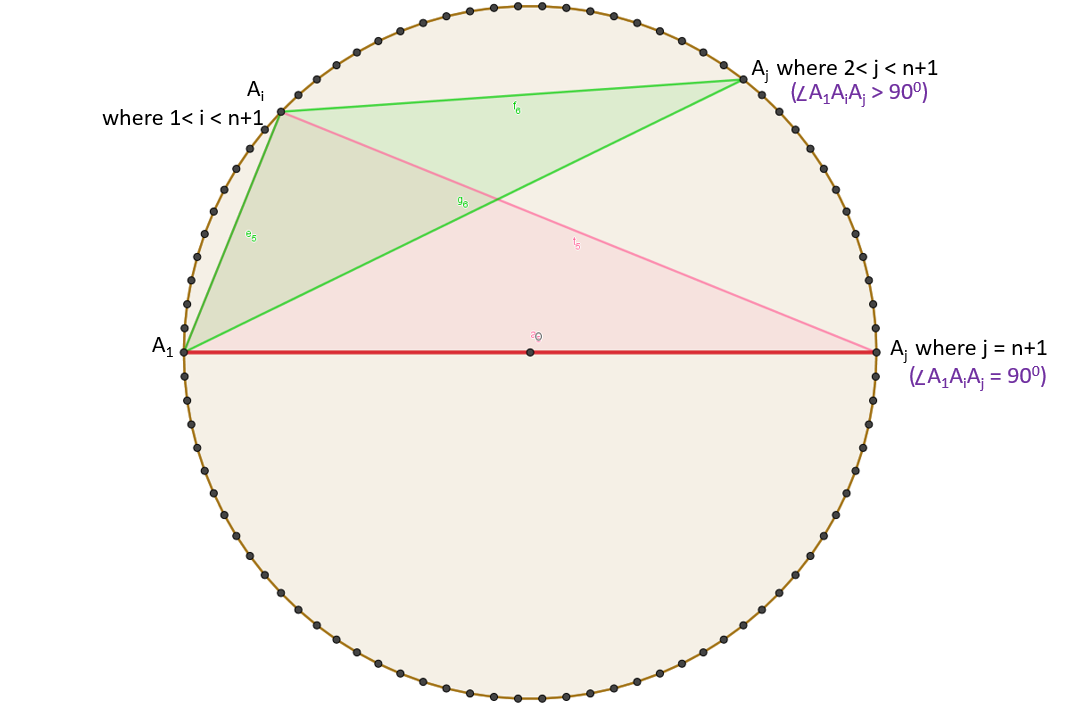New Home › Forums › Math Olympiad - IOQM › Combinatorics › Circle combinatorics
- This topic has 3 replies, 2 voices, and was last updated 7 years, 2 months ago by
 Subrata Ghosh.
Subrata Ghosh.
- AuthorPosts
- April 23, 2018 at 1:43 pm #21249
 Monalisa RoyMember
Monalisa RoyMemberIn a circle,90 equidistant points are drawn on the circumference. How many obtuse angled triangles can be formed by joining any 3 distinct points?
April 23, 2018 at 2:24 pm #21265 Subrata GhoshMember
Subrata GhoshMember
Let us consider 2n equidistant points on a circle.
Let us derive a generic expression through some observations: -1. Since 2n is an even number, each point on the circle will have a diametrically opposite point on the circle. In other words, if we join such diametrically opposite pairs of points we will get n diameters inside the circle.
Each diameter divides the circle into two halves having (n-1) points (excluding the diametrical points). So, if we name one end point of the diameter as A1 then the diametrically opposite point will be the (n+1)th point An+1.
We start with, say, the left most point as shown in the above figure as point A1. We now choose the second point Ai and the third point Aj such that, 1< i < n+1 and 2 < j < n+1 (since Ai is always the second point and Aj is the third point and both are distinct points) that is we remain in the top circle. In a cyclic symmetrical arrangement, we can go on counting either clockwise or anti-clockwise direction to avoid counting same scenario twice. Here we are adopting clockwise counting pattern.
So, we have now reduced the problem of creating the obtuse angled triangle as choosing the first point among any of the 2n points and then choosing the remaining 2 points from the n-1 points available from that first point and its diametrically opposite point.
Hence total no. of obtuse angled triangles, Nobtuse = 2n X (n-1)C2 = n(n-1)(n-2)We also observe that if j=n+1 the triangle becomes right angled. Applying the same method of counting obtuse angled triangles as discussed above, we can say that for each A1 among the 2n points we can choose Ai as one of the n-1 points between the two diametrically opposite points A1 and An+1 to generate a right-angled triangle. (Aj = An+1)
Hence total no. of right angled triangles, Nright = 2n(n-1)We further observe that total no. of triangles, Ntotal = 2nC3 = 2n(n-1)(2n-1)/3
Using, Ntotal = Nobtuse + Nright + Nacute (where Nacute = no. of acute angled triangles) we can derive, total no. of acute angled triangles, Nacute = n(n-1)(n-2) /3
You can try doing the above calculation when the total number of points is odd (2n-1) and show thatNobtuse = (n-1)(2n-1)(n-2)/2
Nright = 0
Ntotal = (n-1)(2n-1)(2n-3)/3
Nacute = n(n-1)(2n-1)/6April 23, 2018 at 2:58 pm #21269 Subrata GhoshMember
Subrata GhoshMemberWhen 2n = 90, n =45 then using the formula derived earlier,
Number of obtuse angled triangles = 45 x 44 x 43 = 85,140
April 23, 2018 at 3:36 pm #21271 Subrata GhoshMember
Subrata GhoshMemberUsing the same formula can we predict the probability of generating an obtuse angled triangle from any 3 randomly chosen points on a circle.
Hint : A circle has infinite number of points ( n ---> infinity)
- AuthorPosts
- You must be logged in to reply to this topic.
